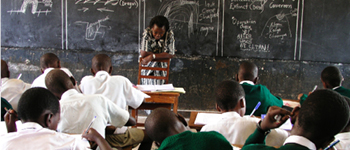Research Brief
What Matters for Learning in East Africa?
- In addition to large class sizes, peer effects, such as overage-for-grade and late-starting pupils, are challenges for the successful development of education sectors in East Africa; there is a comparative lack of research on the impact of peer effects.
- Household surveys provide good data with which to assess the impact of class size and the effect of overage-for-grade pupils on the education sectors of Kenya, Tanzania, and Uganda.
Improving the quality of schooling in low-income countries is a critical challenge facing the development community. Although education has been receiving increasing attention since the early 1990s, there is still a need for more rigorous research on the impacts of education reforms. Substantial research has been conducted on the effects of a reduction in class size on skills acquisition; comparatively less research has focused on the role of peer effects, or class composition, on student performance. Understanding the impacts of both class size and peer effect is crucial to understanding vital education issues in East Africa.
Education sector performance in Kenya, Tanzania, and Uganda

There are marked differences in education sector performance between the three countries: Kenyan pupils outperform Tanzanian pupils by approximately 15 percentage points on each test component, and outperform Ugandan pupils by around 20 percentage points. In terms of class size, classes in Uganda have an average of 84 children, compared to 65 in Tanzania and 56 in Kenya. With respect to age, most pupils in all three countries attend classes in which about one-in-three pupils is overage. This is most pronounced in Uganda, where more than sixty per cent of class peers are overage—despite the fact that the country ostensibly maintains a system of automatic promotion. Tanzania has the lowest percentage of overage-for-grade pupils even though it allows grade repetition.
Peer effects and education quality
The characteristics or composition of pupils in individual classrooms have important ramifications on both student performance and teaching methods. In particular, the age composition of classrooms is an area in need of urgent attention. Classes composed of diverse groups of pupils prove especially challenging for reform efforts—wide age and ability ranges within the same classroom setting can affect overall student performance.
Both class-size reductions and organizational changes to counter peer effects (such as automatic grade promotion) could help improve education in East Africa. However organizational change would not require the same recurrent staff costs and would therefore be less costly. One-off investments to manage overage pupils could represent an efficient use of education aid.
- Costly class-size reductions should not be prioritized over organizational changes by those looking to improve education in East Africa.
- The negative effects of grade repetition and late-starting should receive increased attention in education policy interventions.
However, simply improving resources available to schools in low-income areas will improve overall learning outcomes. Addressing large class sizes and overage-for-grade pupils must not be seen in binary terms but should rather be viewed as one way to improve learning outcomes, with no individual solution valid in all cases.
 Join the network
Join the network